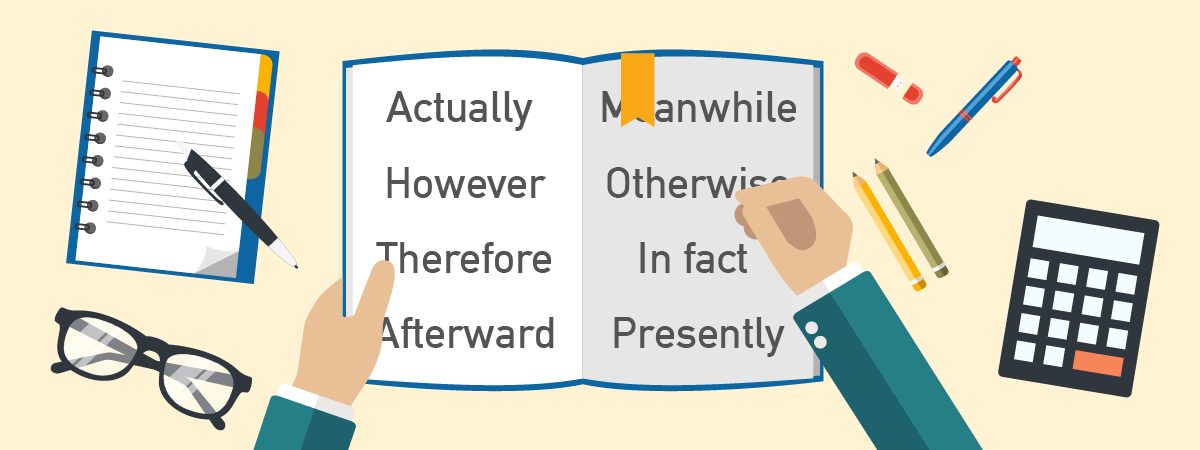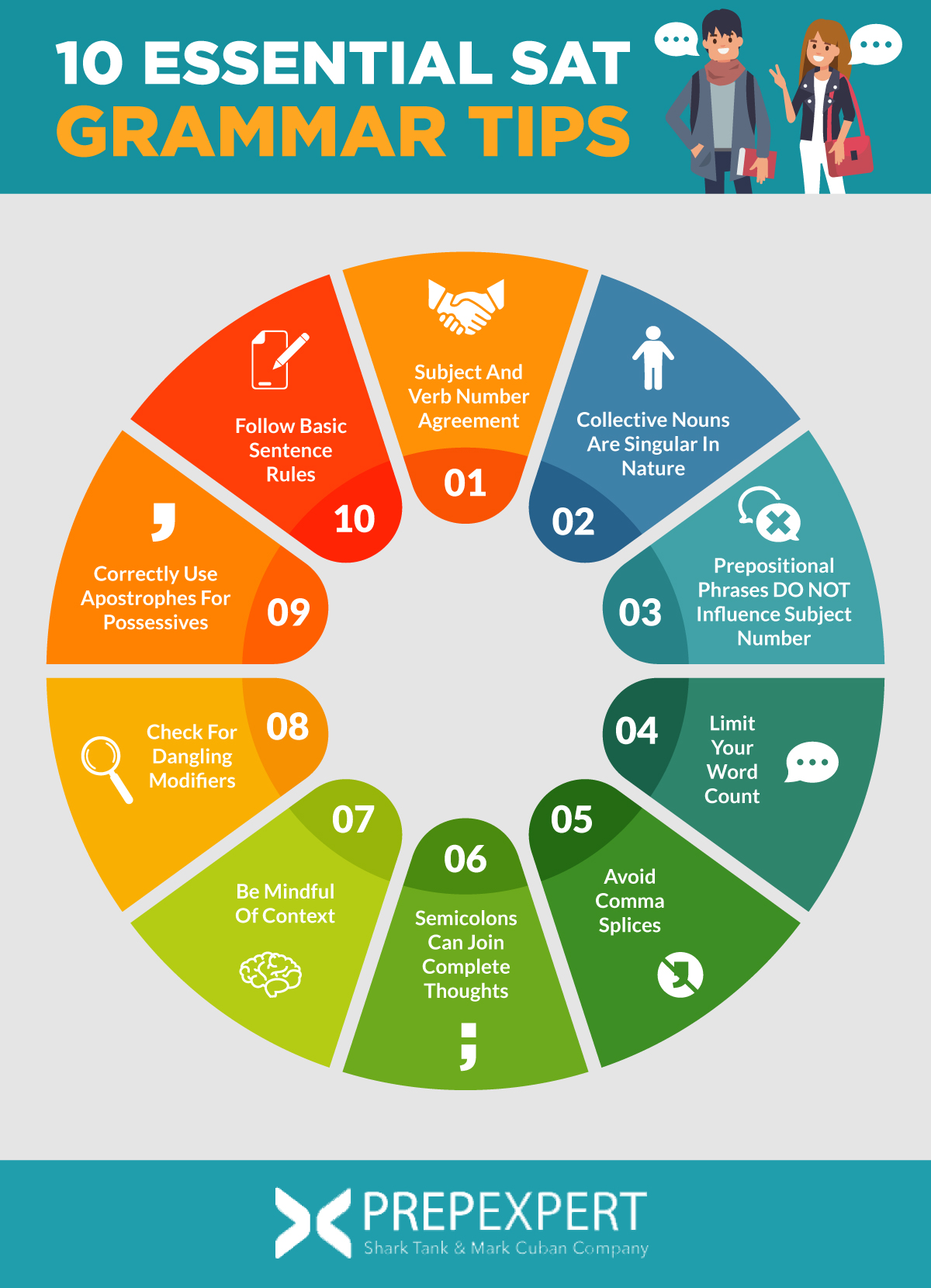10 Essential SAT Grammar Tips
The SAT Writing and Language Test section isn’t as scary as it used to be. However, it’s not a cakewalk either. It presents students with plenty of challenges by making students focus on every grammatical detail.
To make life simpler, here are 10 SAT grammar tips to keep in mind when preparing for the Writing and Language section.
Take a minute today to learn more about our various SAT prep course options.
[sat_one]

Subject And Verb Number Agreement
One grammar rule that’s constantly tested is subject-verb agreement.
One aspect of that rule you have to keep straight is number agreement. What that means simply is this: singular with singular, plural with plural. If your sentence’s subject is singular (meaning one), then the accompanying verb must be singular too.
The same logic applies to a plural subject. A plural verb must accompany a plural subject. Never mix singular and plural together in the same sentence. If you see such a combination on the test, know that it’s there to trip you up.
[leadmagnet_five]

Collective Nouns Are Singular In Nature
To make things confusing, the SAT Writing and Language Test will throw in collective nouns to mess with your understanding of the subject-verb agreement.
What that means for you is this: grouping words, used in context, referring to various individuals are singular subjects. Words like “team”, “group”, “jury”, “crowd”, “class”, “panel”, “committee” are common collective nouns.
If you see one of these words used in a sentence, remember that even though it refers to multiple people, the collection of them is understood as a singular subject; a singular verb must be used in that case. If the word refers to multiple collected groups, like “crowds” for example, then the verb must be plural too.

Prepositional Phrases DO NOT Influence Subject Number
Remember this about prepositions on the test – they are not to be used when determining if the subject is singular or plural.
To determine whether the subject is singular or plural, refer back to the main noun that’s being modified. For example, “the team of players are talented” is incorrect. Why? Because it’s assuming the preposition ‘of’ is referring mainly to players, so it uses are, a plural verb.
The main verb being modified is “team”, which is singular; the sentence should read “the team of players is talented.” The SAT will use prepositional phrase tricks like this to test your understanding.

Limit Your Word Count
Often, shorter sentences are your best friend.
Among answer choices, the shortest yet grammatically correct one that communicates all of the information is correct. Moreover, shorter sentences are much easier to understand and use in writing. On the test, any answer choices that unnecessarily add words or phrases that don’t communicate anything can be discarded.
[sat_two]
Avoid Comma Splices
A comma splice is easy to do; however, it’s incorrect.
Comma splices occur when two complete, independent thoughts (or clauses) are only separated by a comma. Run-on sentences are the most common result of comma splicing.
When using a comma, make sure that both thoughts cannot exist by themselves entirely. If they can exist independently, then you need to adjust your punctuation accordingly.
Semicolons Can Join Complete Thoughts
To easily fix a comma splice, use a semicolon instead.
Semicolons function similarly to periods. They are able to clearly indicate two complete, independent thoughts. More importantly, if those two thoughts refer to one another, a semicolon can link them together.
On the SAT, remember that if you see a semicolon used and both clauses aren’t independent then it’s incorrect. More importantly, if you find a comma splice, substitute a semicolon into the sentence instead.

Be Mindful Of Context
Every word used has to make sense within the context.
The SAT eliminated its once-feared Vocabulary section, meaning that you no longer have to have command of difficult, obscure words. However, the new test will check your understanding of moderately-difficult words. Questions will throw incorrect word choices at you through homophones (words that sound the same but with different definitions) and words with multiple meanings.
One way to check vocabulary in a sentence is to analyze each word and ensure every single one makes sense in the context of the presented information. If a word sounds like it should be correct, but you know it actually means something else then there’s a problem.

Check For Dangling Modifiers
A common error SAT writing questions employ is using dangling modifiers.
In short, modifiers are phrases or words that modify an additional word to provide additional information. If you see a modifier in a sentence that’s followed by a comma, make sure that it is providing more information about the word or phrase that immediately follows. If it does not, then that modifier is dangling. It exists without a purpose within that sentence.
[leadmagnet_two]

Correctly Use Apostrophes For Possessives
You need to understand how to use apostrophes for forming possessives.
The good news? The rules for forming them are easy. First, whether the word is plural or singular if it doesn’t end in “s” then simply add the “s” after the apostrophe. If a plural word already ends in an “s”, then simply add the apostrophe after that “s”.
Also, remember to only use apostrophes for possessives or contractions. There’s no need to use them for anything else. If an SAT question throws one at you outside of those two contexts, then something is wrong.

Follow Basic Sentence Rules
Don’t be fooled by wordiness or incorrect punctuation.
For a sentence to be complete, it must have one primary clause (a subject and corresponding predicate) and correct punctuation. A complete subject can have more than one primary clause, as long as they are hooked together by correct punctuation.
If a sentence doesn’t have a primary clause, then it’s a fragment. Simple as that. Remember that sentence length alone doesn’t signify whether or not a sentence is correctly formed. Look for the subjects and predicates, and make sure that multiple ones are hooked together correctly by either commas or semicolons.
How Prep Expert Can Help You
Want more SAT grammar tips? Join one of our upcoming SAT classes.
Learning grammar rules and drilling them consistently before taking the SAT is in your best interest. At Prep Expert, that’s exactly what we do with the students we work with every year.
Our instructors will both teach you the information and strategies you’ll need to memorize, and give you a chance to practice them through weekly practice tests and homework assignments. Each week, you can check your progress and see which sections give you the most trouble.
By the time you finish our course, you will have a strong idea of what to expect and how to tackle it accordingly. We work with materials derived from previously administered SAT tests; so what we give you is what the real thing will look like on test day.
[sat_three]
For more test strategy, college admissions, and scholarship application tips sign up for our FREE class happening right now!
SAT Grammar Tips FAQ
How important is grammar on the SAT?
The test makers are more than happy to trip you up by slipping grammar mistakes so basic that you might miss them. Unfortunately, missing those details will take off points from your final score.
What’s a common grammar trick used to mess up students?
To make things confusing, the SAT Writing and Language Test will throw in collective nouns to mess with your understanding of the subject-verb agreement.
What’s a trick I can use to find the answer quicker?
Shorter sentences are your best friend. Among answer choices, the shortest yet grammatically correct one that communicates all of the information is correct.
What else should I look out for as far as SAT grammar error tricks?
A common error SAT writing questions employ is using dangling modifiers.



